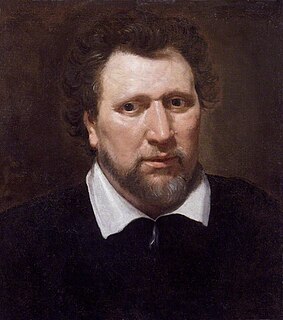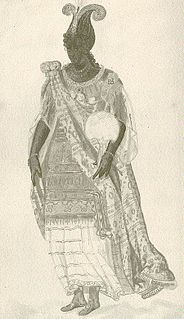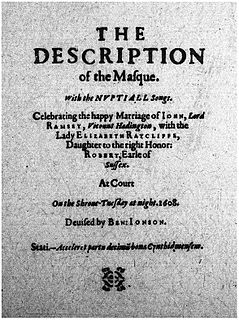
Benjamin Jonson was an English playwright and poet. Jonson's artistry exerted a lasting influence upon English poetry and stage comedy. He popularised the comedy of humours; he is best known for the satirical plays Every Man in His Humour (1598), Volpone, or The Fox, The Alchemist (1610) and Bartholomew Fair (1614) and for his lyric and epigrammatic poetry. "He is generally regarded as the second most important English dramatist, after William Shakespeare, during the reign of James I."

The Masque of Blackness was an early Jacobean era masque, first performed at the Stuart Court in the Banqueting Hall of Whitehall Palace on Twelfth Night, 6 January 1605. It was written by Ben Jonson at the request of Anne of Denmark, the queen consort of King James I, who wished the masquers to be disguised as Africans. Anne was one of the performers in the masque along with her court ladies, all of whom appeared in blackface makeup.
The Masque of Beauty was a courtly masque written by Ben Jonson, and performed in London's Whitehall Palace on 10 January 1608. It inaugurated the refurbished banquesting hall of the palace. It was a sequel to the preceding Masque of Blackness, which had been performed three years earlier, on 6 January 1605. In The Masque of Beauty, the "daughters of Niger" of the earlier piece were shown cleansed of the black pigment they had worn on the prior occasion.
Love's Welcome at Bolsover is the final masque composed by Ben Jonson. It was performed on 30 July 1634, three years before the poet's death, and published in 1641.

Ben Jonson collected his plays and other writings into a book he titled The Workes of Benjamin Jonson. In 1616 it was printed in London in the form of a folio. Second and third editions of his works were published posthumously in 1640 and 1692.
Oberon, the Faery Prince was a masque written by Ben Jonson, with costumes, sets and stage effects designed by Inigo Jones, and music by Alfonso Ferrabosco and Robert Johnson. Oberon saw the introduction to English Renaissance theatre of scenic techniques that became standard for dramatic productions through the coming centuries.
Love Freed from Ignorance and Folly was a Jacobean era masque, written by Ben Jonson and designed by Inigo Jones, with music by Alfonso Ferrabosco. It was performed on 3 February 1611 at Whitehall Palace, and published in 1616.
Love Restored was a Jacobean era masque, written by Ben Jonson; it was performed on Twelfth Night, 6 January 1612, and first published in 1616. The Dictionary of National Biography says of the masque, "This vindication of love from wealth is a defense of the court revels against the strictures of the puritan city."

The Hue and Cry After Cupid, or A Hue and Cry After Cupid, also Lord Haddington's Masque or The Masque at Lord Haddington's Marriage, or even The Masque With the Nuptial Songs at the Lord Viscount Haddington's Marriage at Court, was a masque performed on Shrove Tuesday night, 9 February 1608, in the Banqueting House at Whitehall Palace. The work was written by Ben Jonson, with costumes, sets, and stage effects designed by Inigo Jones, and with music by Alfonso Ferrabosco – the team of creators responsible for previous and subsequent masques for the Stuart Court.
The Golden Age Restored was a Jacobean era masque, written by Ben Jonson and designed by Inigo Jones; it was performed on 1 January and 6 January 1616, almost certainly at Whitehall Palace.
Mercury Vindicated from the Alchemists at Court is a Jacobean-era masque, written by Ben Jonson and designed by Inigo Jones. It was performed at Whitehall Palace on Twelfth Night, 6 January 1615. King James I liked it so much that he ordered a repeat performance the following Sunday, 8 January.
The Fortunate Isles and Their Union is a Jacobean era masque, written by Ben Jonson and designed by Inigo Jones, and performed on 9 January 1625. It was the last masque acted before King James I of England, and therefore the final masque of the Jacobean era.
Neptune's Triumph for the Return of Albion was a Jacobean era masque, written by Ben Jonson, and designed by Inigo Jones. The masque is notable for the contradictory historical evidence connected with it and the confusion it caused among generations of scholars and critics.
The Entertainment at Althorp, or The Althorp Entertainment, performed on 25 June 1603 is an early Jacobean era literary work, written by Ben Jonson. It is also known by the alternative title The Satyr. The work marked a major development in Jonson's career, as the first of many entertainments and masques that he would write for the Stuart Court.
Pleasure Reconciled to Virtue is a Jacobean era masque, written by Ben Jonson and designed by Inigo Jones. It was first performed on Twelfth Night, 6 January 1618, in the Banqueting House at Whitehall Palace. The work's failure on its initial performance, and its subsequent revision, marked a significant development in Jonson's evolving masque technique.
The King's Entertainment at Welbeck in Nottinghamshire, alternatively titled Love's Welcome at Welbeck, was a masque or entertainment written by Ben Jonson, and performed on 21 May 1633 at the Welbeck estate of William Cavendish, 1st Duke of Newcastle. It has been argued that the philosopher Thomas Hobbes may have participated in the entertainment as a performer.
Time Vindicated to Himself and to his Honours was a late Jacobean era masque, written by Ben Jonson and with costumes, sets, and stage effects designed by Inigo Jones. James's son and heir Prince Charles led the dances of the principal masquers, as he had in several previous masques at the Stuart Court.
The Vision of Delight was a Jacobean era masque written by Ben Jonson. It was most likely performed on Twelfth Night, 6 January 1617 in the Banqueting House at Whitehall Palace, and repeated on 19 January that year.
Lovers Made Men, alternatively titled The Masque of Lethe or The Masque at Lord Hay's, was a Jacobean era masque, written by Ben Jonson, designed by Inigo Jones, and with music composed by Nicholas Lanier. It was performed on Saturday 22 February 1617, and was significant in the development and acceptance of opera in seventeenth-century England.
News from the New World Discovered in the Moon was a Jacobean era masque, written by Ben Jonson; it was first performed before King James I on 7 January 1620, with a second performance on 29 February the same year. Jonson's text comments on significant recent developments in astronomy and journalism. The text of the masque was first published in the second folio collection of Jonson's works in 1641.